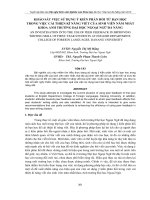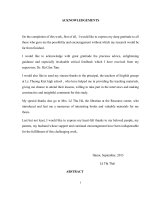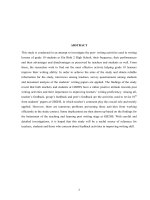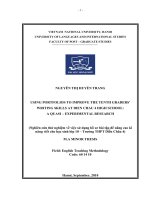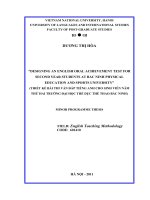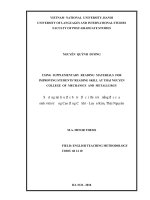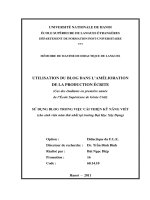Áp dụng portfolio để cải thiện kĩ năng viết cho học sinh lớp 11 tại một trường trung học phổ thông tỉnh lạng sơn
Bạn đang xem bản rút gọn của tài liệu. Xem và tải ngay bản đầy đủ của tài liệu tại đây (1.01 MB, 66 trang )
VIETNAM NATIONAL UNIVERSITY, HA NOI
UNIVERSITY OF LANGUAGES AND INTERNATIONAL STUDIES
FACULTY OF POST-GRADUATE STUDIES
BÙI BÍCH NGỌC
APPLYING PORTFOLIO TO IMPROVE WRITING SKILLS
OF 11TH-GRADE STUDENTS AT A HIGH SCHOOL
IN LANG SON PROVINCE
(Áp dụng portfolio để cải thiện kĩ năng viết cho học sinh lớp 11
tại một trường trung học phổ thông tỉnh Lạng Sơn)
M.A MINOR PROGRAMME THESIS
Field: English Teaching Methodology
Code: 8140231.01
Hanoi – 2019
VIETNAM NATIONAL UNIVERSITY, HA NOI
UNIVERSITY OF LANGUAGES AND INTERNATIONAL STUDIES
FACULTY OF POST-GRADUATE STUDIES
BÙI BÍCH NGỌC
APPLYING PORTFOLIO TO IMPROVE WRITING SKILLS
OF 11TH-GRADE STUDENTS AT A HIGH SCHOOL
IN LANG SON PROVINCE
(Áp dụng portfolio để cải thiện kĩ năng viết cho học sinh lớp 11
tại một trường trung học phổ thông tỉnh Lạng Sơn)
M.A MINOR PROGRAMME THESIS
Field: English Teaching Methodology
Code: 8140231.01
Supervisor: Nguyễn Thị Hương, PhD.
Hanoi - 2019
DECLARATION
I certify that the work presented in this research report has been performed and
interpreted solely by myself. I confirm that this paper is submitted in fulfillment of the
requirement for the M.A. Degree and has not been submitted elsewhere in any other
form for the fulfillment of any other degree or qualification.
Hanoi, 2019
Bùi Bích Ngọc
i
ACKNOWLEDGEMENTS
It was a long journey with many challenges and difficulties but fascinating to
work on this dissertation. The dissertation required more efforts so it would never have
been completed without the supports and assistances of many people.
First and foremost, I would like to send a special thanks to my academic supervisor Dr. Nguyen Thi Huong for her effortful support, prompt guidance and detailed
feedbacks and especially, her helpful suggestions and encouragement which assists me
to find out the right direction and complete this dissertation. I also would like to express my appreciation to the lecturers of the University of Languages and International
Studies for providing me with comprehensive knowledge and supporting me in my
master course.
Finally, I would like to express my sincere gratitude to my family who always
encourages and unfailingly supports me throughout my year of study and the period of
doing my dissertation. Also, I am thankful to all my colleagues (Nguyen Bich Hien,
Phan Thu Huong, Du Ai Hue Chi, Nguyen Phuong Thuy, Nong Thi Hao and the others), especially thanks to my beloved husband, Nguyen Huu Duyet who continuously
encourages and helps me cope with the difficulties at University as well as in my personal life. Without their enthusiastic assistances and strong supports, I definitely cannot accomplish my dissertation and finish my master course at University of Languages and International Studies.
30th September 2019
Ha Noi, Viet Nam
Bui Bich Ngoc
ii
ABSTRACT
One of the effective approaches helping students to sharpen their writing skills,
which is currently being overshadowed by other skills in teaching and learning English, is Writing Portfolio. However, this method has not been applied widely at high
schools in Vietnam in general and Lang Son in particular. Thus, this study is conducted
to examine how Writing Portfolio influences students’ writing skills as well as how
students think about its implementation. The study adopts action research with the use
of both quantitative and qualitative data collection methods, including writing assignment evaluation, questionnaire, and interviews.
The research’s findings reveal some significant improvements in participants’
overall writing scores, as well as in each of the criterion, namely task achievement, coherence and cohesion, grammar and vocabulary. By being given the marking rubrics,
the educator’s regular feedback and chances to revise and rewrite the writings, the language learners can better monitor their progress in writing.
Apart from that, though most of the students think this activity has positive influences on their writing skills, they still fail to see the advantages of this improvement
to their language acquisition process as writing skill has not been included properly in
testing. Therefore, they do not think it’s necessary to apply Writing Portfolios in the
next academic year.
Despite the positive outcome of the research, there is still a need for further
studies to assess more Writing Portfolio’s effects and the best way to apply Writing
Portfolio in official school curricular.
iii
TABLE OF CONTENTS
DECLARATION .............................................................................................................i
ACKNOWLEDGEMENTS ...........................................................................................ii
ABSTRACT ...................................................................................................................iii
LIST OF TABLES .......................................................................................................vii
LIST OF FIGURES ....................................................................................................viii
CHAPTER 1: INTRODUCTION ................................................................................. 1
1.1. Rationale of the study .......................................................................................... 1
1.2. Aims and objectives of the study ........................................................................ 2
1.3. Scope of the study ................................................................................................ 3
1.4. Significance of the study ...................................................................................... 3
1.5. Methods of the study ........................................................................................... 4
1.6. Structure of the thesis .......................................................................................... 4
CHAPTER 2: LITERATURE REVIEW ..................................................................... 6
2.1. Writing skills ........................................................................................................ 6
2.1.1 Definition of writing skills ................................................................................ 6
2.1.2. Paragraph writing ........................................................................................... 6
2.2. Approaches to teaching writing.......................................................................... 7
2.3. The role of teachers in teaching writing ............................................................ 8
2.4. Assessment of writing ........................................................................................ 10
2.4.1. Types of writing assessment .......................................................................... 10
2.4.2. Scoring method for paragraph writing ......................................................... 10
2.5. Portfolio Assessment .......................................................................................... 11
2.5.1. Definitions of Portfolio .................................................................................. 11
2.5.2. Types of portfolio........................................................................................... 12
iv
2.5.3. The advantages of portfolio........................................................................... 13
2.5.4. Portfolio writing assessment procedure ........................................................ 13
2.6. Related Studies ................................................................................................... 14
CHAPTER 3: RESEARCH METHODOLOGY ...................................................... 17
3.1. Setting of the study ............................................................................................ 17
3.2. Participants ........................................................................................................ 17
3.3. Research design .................................................................................................. 18
3.4. Data collection procedure ................................................................................. 22
3.4.1. Writing assignments ...................................................................................... 22
3.4.2. Questionnaire ................................................................................................ 22
3.4.3. Interviews ...................................................................................................... 23
3.5. Data analysis....................................................................................................... 23
CHAPTER 4: FINDINGS AND DISCUSSIONS .................................................. 25
4.1. Research question 1 ........................................................................................... 25
4.1.1. Effects of writing portfolios on students’ task-fulfillment ............................. 25
4.1.2. Effects of writing portfolios on students’ coherence and cohesion............... 27
4.1.3. Effects of writing portfolios on students’ vocabulary ................................... 28
4.1.4. Effects of writing portfolios on students’ grammar ...................................... 30
4.1.5. Effects of writing portfolios on students’ overall writing skill. ..................... 32
4.2. Research question 2 ........................................................................................... 33
4.2.1. Students’ opinions about the benefits of the writing portfolios in general,
marking criteria and teacher’s feedback in particular. .......................................... 34
4.2.2. Students’ opinions about teacher’s instructions ........................................... 36
v
4.2.3. Students’ opinions about the application of Writing Portfolios in the next
academic year.......................................................................................................... 37
4.3. Discussions .......................................................................................................... 39
CHAPTER 5: CONCLUSION .................................................................................... 41
5.1. Major findings of the study ............................................................................... 41
5.1.1. The effects of Writing Portfolios on students’ writing skills ......................... 41
5.1.2. Students’ opinions about Writing Portfolio implementation in class ........... 42
5.2. Implications ........................................................................................................ 43
5.3. Limitations of the study..................................................................................... 43
5.4. Suggestions for further studies ......................................................................... 44
REFERENCES ............................................................................................................. 45
APPENDICES ................................................................................................................ I
1. Marking rubrics for writing assignments .......................................................... I
2. Questionnaire ...................................................................................................... V
3. Interviews........................................................................................................... VI
3.1. Participant 1 ..................................................................................................... VI
3.2. Participant 2 ..................................................................................................... VI
3.3. Participant 3 .................................................................................................... VII
3.4. Participant 4 .................................................................................................... VII
3.5. Participant 5 ................................................................................................... VIII
4. Samples of student’s writing and teacher’s feedback.................................... IX
vi
LIST OF TABLES
Table 1. The percentage of students arranged by results of task fulfillment criterion .. 26
Table 2. The percentage of students arranged by results of coherence and cohesion
criterion .................................................................................................................. 27
Table 3. The percentage of students arranged by results of vocabulary criterion ........ 29
Table 4. The percentage of students arranged by results of grammar criterion ........... 31
Table 5. The percentage of students arranged by results of writing assignments ........ 33
vii
LIST OF FIGURES
Figure 1. The percentage of students arranged by results of vocabulary criterion for the
1st assignment ........................................................................................................ 29
Figure 2. The percentage of students arranged by results of grammar criterion .......... 32
Figure 3. Students' opinions on their involvement in Writing ...................................... 34
Figure 4. Students’ degree of agreement in their improvement in all aspects .............. 35
Figure 5. Students' opinions on the appropriateness of the teacher's instruction .......... 36
Figure 6. Students' opinions on carrying out Writing Portfolios in the future .............. 38
viii
CHAPTER 1: INTRODUCTION
In this chapter, the rationale, aims and objectives, significance of the study are
presented. Also, the research questions, chosen research methods and structure of the
researcher are put forward.
1.1. Rationale of the study
Learning English as a foreign language has been made compulsory in the majority of high schools in Vietnam. Based on the current curriculum, it is evident that the
teaching of English at this level places equal emphasis on all four skills, namely reading, speaking, listening and writing. As a teacher of English, I come to realize that
many high school students, including mine, find writing skills a hard one to master. In
fact, even though it is more challenging to acquire writing skills than others, both
teachers and students seem not to pay enough attention to it.
To be more specific, after having spent a long time agonizing over the reasons
for the issue, as I am aware, part of this may lie in the fact that high school students are
not provided with adequate comments and chances to revise their writings after receiving comments from their teachers or peers. According to Oshima and Hogue (1997),
there are four steps in the process of writing, consisting of prewriting, planning, writing
and revising drafts, and writing the final copy. However, in my teaching context, the
majority of the writing lessons in class normally lack the final step of the process,
which is revising drafts and writing the final copy. To be more specific, in the first section, the teacher leads in the lesson and gives students a writing sample to analyze, and
then, some necessary words, structures, and expressions are supplied. In the next stage,
students have approximately 15 to 20 minutes to start writing based on what they have
learned from the previous stage. Normally, one or two learners will be called on to
write their writings on the board. Lastly, it is time for the teacher to correct the writing
on the board, give feedback and score. The problem is, as the educator’s comments and
1
feedback put an end to the writing process, students will not have the opportunity to
revise as well as rewrite their writing. Of course, they can do this step at home and ask
for teacher’s help to comment on their writings the second time. However, this can
hardly happen in real life as Vietnam still follows the exam-driven curriculum, which
is believed to make a large proportion of students learn English to pass the national exam solely and in most of the tests, students’ writing skills are only measured by multiple choice questions. Le (2000) revealed that Vietnamese learners have the extrinsic
motivation as a result of the pressure to pass exams. As a result, they cannot see the
benefits of the rewriting step in a writing lesson and often ignore it. Besides, due to the
large number of students in one class and the time limit, some teachers cannot evaluate
the writing abilities of all students in the classroom. In fact, she/he even gives scores to
the writing of some students only, without giving feedback. Consequently, students
rarely realize their mistakes and errors in writing. Therefore, their progress in writing
skills can hardly be observed. In conclusion, I regard the lack of the rewriting step and
teachers’ remarks a significant contribution to the deficiency in students’ writing skills.
Looking for a solution to the issue, I have read a number of studies examining
methods to improve students’ writing skills at different levels. I come to realize that
writing portfolios are being used at a wide range of universities in Vietnam. Besides, in
one of those studies, E-portfolios at high school level proposed by Nhi and Mai (2018)
have shown considerable potentials. Therefore, I suggest that improving my high
school students’ writing abilities may be achieved by using portfolios in teaching and
learning English as a foreign language.
1.2. Aims and objectives of the study
The study is conducted to investigate the efficiency of adopting portfolio in improving the writing skills of 11th students at a high school in Lang Son province. The
progress that students make can be observed in their own portfolios after a semester.
2
Additionally, the paper aims to find out students’ viewpoints on the use of portfolios in
class in term of the effectiveness of portfolios and the obstacles that they encounter
while applying portfolios.
In short, the objectives of the study could be summarized into research questions as followed:
1. To what extent does portfolio help to improve writing skills for 11th grade students
at a high school in Lang Son city?
2. What are students’ opinions about applying portfolio in writing skills?
1.3. Scope of the study
The intent of this study is to investigate the impact of Writing Portfolios on nonEnglish major 11th-grade students at a high school in Lang Son city. The chosen participants are from an intact group who are taught by the researcher due to the time and
logistic constraint. It should be noted that students at this level are only required to
write paragraphs instead of the whole essays. There are 4 criteria that should be considered when evaluating students’ writing skills, including task fulfillment, coherence
and cohesion, vocabulary and grammar. In addition, this study focuses on the participants’ opinions of Portfolio application in writing skills at high school level.
1.4. Significance of the study
Once the study is completed, it will serve to investigate the use of portfolio as a
recommended activity in writing skill lessons. Thus, it may be of considerable use for
other English teachers in this high school or researchers who want to investigate more
in applying portfolios to high school students to enhance their writing skills.
Furthermore, as the study is an action research, it helps to enhance the validity of
the feasibility of portfolio using at schools. Therefore, the recommendations and conclusions from the study could be useful to the policymakers in other schools nationwide if portfolios are considered to be applied into school curricula.
3
1.5. Methods of the study
The study is carried out as an action research. To be more specific, writing portfolios would be applied directly into the class that the researcher is teaching. In this
study, portfolios are integrated in teaching writing lessons at class. After the research is
completed, the effects of portfolios would be assessed so that some recommendation
would be given to make portfolios a mandatory in-class activity in the official curricula
in the researcher’s school.
Also, both qualitative and quantitative data collection methods are applied into
this research. In terms of qualitative method, interviews are used to gather student’s
attitudes towards portfolios activities in class. When it comes to the quantitative method, a questionnaire and writing assignments would be applied. The results of students’
writing assignments would be calculated to determine the effects of portfolios on the
students’ writing scores. Both the methods are triangulated to enhance the validity and
reliability of the study. The results from the writing assignments would be compared
with the data collected in the interviews and questionnaire.
1.6. Structure of the thesis
The thesis entitled “Applying portfolio to improve writing skills of 11th-grade
students at a high school in Lang Son province” comprises five main chapters: Introduction, Literature Review, Methodology, Data analysis and Findings along with Conclusion and Recommendation, followed by the List of References and Appendices.
Chapter 1: Introduction
This chapter provides a general background and clarifies the rationale of this research. Besides, research aim and objectives as well as research questions are also
specified. In general, the Introduction serves as an overview of this study.
Chapter 2: Literature Review
In this chapter, through studying the existing literatures, the definition of key
terms including writing skills and portfolios are provided. Besides, the previous studies
4
by other researchers are also mentioned.
Chapter 3: Methodology
The research process is demonstrated in detail through each stage. Apparently,
the setting, participants, research design will be discussed. Additionally, data collection
procedure, and data analysis are also justified.
Chapter 4: Findings and Discussions
After data collection process, the findings from students’ portfolios are introduced in this chapter. These data are analysed thoroughly to answer the research questions. Additionally, the result comparison to the previous studies is given in the Discussions section.
Chapter 5: Conclusion
This final chapter summarises the results from all analyses of the prior sections
as well as provides some recommendations for further research. Besides, the possibility
of limitations is also recognized in relation to the outcomes of this study.
5
CHAPTER 2: LITERATURE REVIEW
This chapter would examine and analyze relevant aspects that are related to the
aim of the thesis. First, it commences from analyzing Writing skills in terms of its definition, paragraph writing and process of writing. The next parts are approaches to
teaching writing, the role of teachers in teaching writing, and assessment of writing.
Finally, after the Portfolio Assessment is reviewed, a brief overview of related studies
discloses the research gaps and justifies the aims and objectives of this research paper.
2.1. Writing skills
2.1.1 Definition of writing skills
Writing is a visual representation of speech which writers use to communicate
their ideas and feelings. Together with speaking skills, writing skills is considered a
productive one, which involves actively producing the language instead of passively
receiving it. In other words, learning how to write in a second language is not merely
trying to arrange the conventional symbols of the writing system that represent the utterances one has in mind. It requires the learners to apply suitable words, use grammar
with ease and present facts in the order of time and space. According to Lounis (2009),
writing is the most integral skill that needs to be mastered by ESL or EFL learners.
However, the process of writing is not as simple as it is assumed. In 2002, Richard and
Renandya stated that writing is regarded as the most challenging skill compared to others in teaching and learning a language.
2.1.2. Paragraph writing
A paragraph is a group of sentences about a single topic. They are fundamental
building blocks of texts. Their main purposes are to inform news, state opinions, give
facts or provide explanations. When it comes about the structure of a paragraph, in academic writing, it is required to include at least 5 to 7 sentences in one paragraph. In
general, a paragraph consists of three main components, including a topic sentence,
6
several supporting sentences and a concluding sentence. The topic sentence is usually
the first sentence of a paragraph. It is basically a summary of the argument the writer is
making in the paragraph. The supporting sentence gives example, explanation, information and opinion to support the main idea stated in the topic sentence of the paragraph. Therefore, all supporting sentences should help the reader to understand the topic and focus of the paragraph. Concluding sentence is normally the last one in the paragraph. It is often similar to the topic sentence in which it reminds the reader of the topic and focus of the paragraph. However, different words and ways of expressing should
be used, if possible. Besides, in order for a paragraph to be effective, it must have 3
following characteristics: unity, coherence and paragraph development. Unity means
that all sentences in the paragraph are written to explain, develop, and support a central
idea which is stated in the topic sentence. As regards coherence, the paragraph must be
easy to read and understand by the organization of supporting sentences in a logical
order and the appropriate use of transitional signals. Last but not least, it is important to
fully develop and discuss the topic of the paragraph. A good rule of thumb to stick to is
to make sure that a paragraph contains at least four sentences explaining and elaborating on the topic sentence. Some suggested ways that the writers can use to develop and
support the topic sentence is using examples, telling a story to illustrate the idea, comparing and contrasting, and showing data.
2.2. Approaches to teaching writing
Product approach to teaching writing skills appeared in the mid-1960s, attending to the final product without focusing on the writing procedure or to the writers
themselves. The normal procedure is to assign students a piece of writing, collect their
final products, and give them back for further revision with the mistakes either corrected or marked for the students to do the corrections (Raimes, 1983). In other words, in
this teaching method, teachers do not act as a facilitator of learning, and students’ work
as an indication of achievement is the only focus.
7
Approximately 20 years later, in the mid 1980s, there was a shift from product
approach to process approach which place more emphasis on the process of composing
texts rather than on the products themselves. Oshima and Hogue (1997) state that the
process of writing comprises 4 steps in total, including prewriting, planning, writing
and revising drafts, and writing the final copy. To be more specific, in the first step, the
writing topics are chosen and narrowed down as well as the ideas are brainstormed.
Subsequently, these ideas are organized, and the outline of the writing is drawn up.
Writers are highly likely to revise several drafts before making the final copy of their
product. As Oshima and Hogue claim, there is no writing that is flawless in its first
draft; therefore, writers have to refine and improve their writing until they feel contented with the final writing version. Similarly, Harmer (2004) also says that 4 main stages
are required in order to create a great writing: planning, drafting, editing and final version. In the planning stage, writers think about the topic they are going to write. Simultaneously, the purpose of writing and the organization of the facts will be decided. Afterwards, they start to write the first draft or even several drafts. Editing the writing is
the next stage in which writers can ask for readers’ comments or suggestions. At the
last stage, the final version is completed.
One more approach that can be reviewed is genre approach, in which information concerning the types of writing is provided. The notion of genre stem from the
idea that writing is situational; hence, good writing is determined by the context, purpose and the audience. In conclusion, genre-based approach gives students chances to
get to know a wide range of purposes of writing and deal with various ways of writing
in formation.
In conclusion, it should be noted that process approach is the one that is advocated in this study.
2.3. The role of teachers in teaching writing
In teaching writing skills, teachers act as facilitators who supply students with
8
support so that they can produce their own good writings. Brown (2001) says that
teachers are the ones who give responses to students’ writing. He also highlights teachers’ guidance instead of forcing students to follow their thoughts. In addition to this,
Harmer (2004) indicates five responsibilities teachers have to take during the writing
process. They are presented as follows:
(1) Demonstrating: teachers are responsible for introducing to the students the various
genre constrains and writing conventions so that students are mindful of what they
are going to write.
(2) Motivating and provoking: Brainstorming ideas and choosing appropriate vocabulary are the most common challenges to students when they are dealing with the
writing assignments. Teachers can make some connections between reality and the
writing assignments to keep students motivated or plan various kinds of tasks as an
introduction to writing. Some suggested activities are rearranging a jumbled paragraph or finishing an uncompleted paragraph.
(3) Supporting: During the writing process, students are likely to encounter difficulties.
By being available in the class and offering constructive advice, teachers are the
ones who encourage the students confront the problems.
(4) Responding: When making response to students’ writing, teachers can give comments or suggestions for students to improve their writings. It should also be noticed that these suggestions belong to the writing process, not the evaluation procedure.
(5) Evaluating: This task is performed at the end of the writing process by the teacher
when students finish the last version of the writing assignment. Through this step,
students’ work is marked and the progress they have made is observed.
To sum up, a teacher acts as a demonstrator, a motivator, a supporter, a responder
and an evaluator.
9
2.4. Assessment of writing
2.4.1. Types of writing assessment
In teaching and learning language, particularly in writing skills, in order to
measure the progress and examine the achievement that students have made, teachers
can adopt some forms of assessment, including the traditional and the alternative ones.
To be more specific, traditional assessment requires learners to select a possible answer
from a given list of choices, which also means students’ writing are assessed at
sentence level only. Brown (2004) also states that the characteristic of the traditional
writing assessment is the emphasis on the correct answers as well as the final products.
Besides, he points outs that alternative assessment requires students to perform, produce, or do something at text level. Portfolios, journals, self-assessment and peerassessment are categorized as means of alternative assessments. In fact, a wide range
of alternative assessments are being increasingly deployed due to the students’ involvement in learning.
2.4.2. Scoring method for paragraph writing
There are 3 types of scoring method, which are holistic, primary trait and analytical scoring (Brown, 2004). Holistic scoring is used to judge the writing assignment
of the student by giving one single, integrated score only after the educator reads the
whole text. In other word, the score given is mostly based on the personal assumption
of the teacher as a reader. The aim of this method is generally used to rate the writer’s
overall proficiency. Hyland (2003) suggests that holistic scoring method concentrates
on what writers can do well instead of diagnosing writers’ deficiencies. Although this
approach is easy to use with larger classes, it is believed to undervalue the process in
which learners plan their writings.
Besides, if the assignment only concentrates on a particular aspect of writing, or
a specific linguistic form, or the use of a certain semantic group, primary trait scoring
allows the instructor and the students to focus their feedback and attention specifically.
10
In terms of the last type of scoring method, Weigle (2002) defines analytical
scoring method as a way to evaluate students’ writing assignments based on the components of writing such as content, organization, language use, and mechanics. The
idea behind analytical scoring is that writing quality is not a holistic unified scale but a
combination of certain distinct features. As this scoring method is believed to be more
helpful in diagnosing students’ writing abilities than holistic and primary trait scoring,
it will be used in this study.
2.5. Portfolio Assessment
2.5.1. Definitions of Portfolio
In fact, portfolios have been used for many years in a wide range of areas, for
example mathematics, chemistry, teacher training, etc. As for the assessment of language skills, the application of portfolios is a growing trend and has been of dramatic
interest to teachers for the past few decades (Douglas, 2000). There are various definitions of portfolio. According to Hyland (2003), portfolios consist of various writing
samples which are written over a period of time and give description on students’ development and ability in a certain context. He also adds that portfolio assessment refers
to students’ practice of writing by using some information sources as reference, revising and resubmitting it after receiving constructive comments from their partners and
teachers. Barnard and Deyzel (2003) defines portfolio as a “portable, systematic, purposeful collection of work, selected to provide information about attitude, level of development and growth during a given period of time”. Another definition of portfolio,
as Yang (2003) states, is a collection of students’ activities which record the effort as
well as the progress in learning process and their reflection on the materials. In general,
a portfolio is a purposeful collection of students’ work that exhibits their efforts, progress with achievement in one or more aspects. Portfolios offer a way of assessing students’ writing skills that is quite distinct from the traditional methods. To be more precise, while traditional achievement tests offer outcomes in units that can be counted,
11
portfolios assessment offers the teachers opportunities to observe students in a more
general context: taking risks, seeking optimal solutions, and learning to make judgments about their own performances. It is a portfolio when a student is a participant in,
rather than the object of assessment.
2.5.2. Types of portfolio
The types of portfolios are varied according to their purposes and collected
items in it. Consequently, many researchers define different types of portfolios. As Columba and Dolgos (1995) say, there are 3 types of portfolios for classroom use, including Showcase, Teacher-Student and Teacher Alternative Assessment Portfolios. To be
more specific, showcase portfolios are designed to display a leaner’s best quality of
work. In other words, it aims to demonstrate the highest level of achievement attained
by the students. The main idea of this portfolio is that the developer chooses what to
showcase and how to recognize it. What creates the difference between this type of
portfolio and the other two types is that this portfolio is completely individualized and
is based on the perceptions the developers make on himself or herself. Concerning
Teacher-Student Portfolios, they are also called “working portfolios” or “working
folders” that are to assist interaction as well as communication between teacher and
students. The content of this portfolio is discussed and agreed by both the teacher and
his/ her student. Last but not least, all items in Teacher Alternative Assessment Portfolios are scored, rated, ranked or evaluated. Teacher can keep individual student portfolios at their disposal as an assessment tool.
However, according to Epstein (2005, p. 2), portfolios can be divided into two
categories: Process-oriented Portfolios which tell the story of a students’ growth over
time and Product-oriented Portfolios which are a collection of a student’s best work.
Both of these types are used in all grade levels. Nevertheless, it also should be noted
that the Process-oriented Portfolio is considered to be more common at elementary levels since individual progress is likely to be of more concern than determining specific
12
levels of performance. The product-oriented portfolio, on the other hand, is more suitable for advanced levels as mature students generally have higher thinking skills to
choose their best work as well as to engage themselves in deep self-reflection processes (Sweet, 1993; Epstein, 2005).
2.5.3. The advantages of portfolio
The advantages of portfolios have been mentioned by many of the experts. In
1994, Moya and O’Malley claimed that portfolio assessment is one kind of alternative
assessment that not only provide information about students’ weaknesses and strengths
but also keeps records of their development. Besides, by giving students chances to review their own work and better understand what they have learned, portfolios are said
to encourage students to self-reflect and self-evaluate.
Being more specific, Brown (2004, p. 257) lists some of the benefits obtained from
portfolio assessment as follows:
(1) It can help to promote students’ intrinsic motivation, ownership and responsibility.
(2) It assists in promoting the interaction between students and teachers as well as students and their peers.
(3) It provides valuable and reliable information about students’ work.
(4) It aids critical thinking, self-assessment, and revision process.
(5) It allows assessment of multiple aspects of language learning.
2.5.4. Portfolio writing assessment procedure
It is believed that several steps are required to be done by the teacher if portfolio
assessment is applied to measure students’ learning development. As Birgin and Baki
proposed in 2007, there are three steps in developing portfolio assessment, including:
(1) Identifying the purpose of the portfolio
(2) Determining the evidence included in the portfolio
(3) Selecting the assessment criteria
In addition to these steps, Brown (2004, p. 257) adds more in preparing portfo13
lio assessment as presented below.
(1) Determining the aim of the portfolio: It should be noted that the aim of the portfolios must be in line with the integrated goal of the school curriculum.
(2) Considering the evidence included in the portfolio: In this step, the students are
given a sample from which students draw conclusion about the content of the portfolio.
(3) Communicating the assessment criteria: This is regarded as the most complicated
aspect of portfolio assessment as both self-assessment and teacher’s assessment has
to be integrated and published clearly to the students.
(4) Deciding the time for portfolio development: Teachers should make sure that students have sufficient time to finish their writings as well as to self-reflect on them.
(5) Determining regular schedules to review and conferencing: Teachers and students
should arrange discussion sections in which the details about students’ progress are
mentioned personally.
(6) Choosing a place to keep portfolios: A place in the reading room or at the school’s
library is more convenient for teachers and students to keep portfolios.
(7) Giving positive washback and final assessment: Brown (2004, p. 259) also put forward a recommendation that teachers should use holistic scoring method to evaluate students’ portfolio.
(8) Final assessment
2.6. Related Studies
There are quite a few researchers who conducted studies on deploying portfolios
to improve writing skills. Their findings have supported the fact that portfolio is an authentic assessment in teaching and learning English as well as a useful approach to
sharpen writing skills.
14
To begin with, Shober (1996) conducted a study to investigate how helpful a
portfolio can be in showing students’ progress in narrative writing in a period of 12
weeks. After the treatment, he reached a conclusion that there was a marked impact on
students’ progress in narrative writing. In 2012, Tabatabaei and Assefi also undertook a
study in which the impact of portfolio assessment technique as a teaching, learning and
assessment tool on writing skills was examined. They even took sub skills of writing
into consideration. In the study, forty Iranian EFL learners were classified into 2
groups, including the experimental group and the control one. The former group received portfolio assessment while the latter had the conventional approach of writing.
The results of this study revealed that writing skills, especially sub-skills of writing including organization, vocabulary, and elaboration were improved significantly to the
experimental group. Similarly, Aydin in 2010 indicated that portfolio keeping helps
students to enhance their vocabulary and grammar learning and practice. Andrew and
Romova (2011) found enormous benefits of the use of a multi-draft, which is one
essential component in writing portfolios. It is considered as an effective evaluation
tool, because it improves learners’ understanding of writing as a recursive process and
the student gains a sense of progress and hence builds up their confidence. In Vietnam,
there are also researchers who carried out studies on E-portfolios. Two teachers at a
high school in Soc Trang province, Tran Thi Que Nhi and Le Xuan Mai (2018), aim at
investigating the students’ perceptions of the use of E-portfolios in an EFL writing
class. The results showed that the contributions of e-portfolios were highly appreciated
regarding the improvement in teacher-student interactions, as well as in learners’ confidence and motivation for writing. Besides, no significant problems were found in using E-portfolios. Despite some studies on E-portfolios at high schools and writing
portfolios at universities, there are hardly any studies in Vietnam investigating applying writing portfolios with high school students.
In terms of learners’ attitudes towards portfolio assessments, in 2008, Wang and
15


